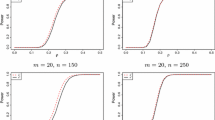Abstract
We present results of a simulation study regarding the finite-sample type I error behavior of the self-concordant profile empirical likelihood ratio (ELR) test for the population correlation coefficient. Three different families of bivariate elliptical distributions are taken into account. Uniformly over all considered models and parameter configurations, the self-concordant profile ELR test does not keep the significance level for finite sample sizes, albeit the level exceedance monotonously decreases to zero as the sample size increases. We discuss some potential modifications to address this problem.
Access this chapter
Tax calculation will be finalised at checkout
Purchases are for personal use only
Similar content being viewed by others
References
Aitchison J (1964) Confidence-region tests. J R Stat Soc B 26:462–476
Anderson TW (1984) An introduction to multivariate statistical analysis, 2nd edn. Wiley series in probability and mathematical statistics. Wiley, New York
Byrd RH, Lu P, Nocedal J, Zhu C (1995) A limited memory algorithm for bound constrained optimization. SIAM J Sci Comput 16(5):1190–1208
DiCiccio T, Hall P, Romano J (1991) Empirical likelihood is Bartlett-correctable. Ann Stat 19(2):1053–1061
Dickhaus T (2014) Simultaneous statistical inference with applications in the life sciences. Springer, Berlin
Eltoft T (2006) On the multivariate Laplace distribution. IEEE Signal Process Lett 13(5):300–303
Genz A, Bretz F (2009) Computation of multivariate normal and t probabilities. Lecture notes in statistics, vol 195. Springer, Berlin
Gupta AK, Varga T, Bodnar T (2013) Elliptically contoured models in statistics and portfolio theory, 2nd edn. Springer, New York
Hall P, La Scala B (1990) Methodology and algorithms of empirical likelihood. Int Stat Rev 58(2):109–127
Kotz S, Nadarajah S (2004) Multivariate t distributions and their applications. Cambridge University Press, Cambridge
Owen AB (1990) Empirical likelihood ratio confidence regions. Ann Stat 18(1):90–120
Owen AB (2001) Empirical likelihood. Chapman & Hall/ CRC, Boca Raton
Owen AB (2013) Self-concordance for empirical likelihood. Can J Stat 41(3):387–397
Spokoiny V (2012) Parametric estimation. Finite sample theory. Ann Stat 40(6):2877–2909
Tsao M (2013) Extending the empirical likelihood by domain expansion. Can J Stat 41(2):257–274
Tsao M, Wu F (2013) Empirical likelihood on the full parameter space. Ann Stat 41(4):2176–2196
Tsao M, Wu F (2014) Extended empirical likelihood for estimating equations. Biometrika 101(3):703–710, doi:10.1093/biomet/asu014
Wilks SS (1938) The large-sample distribution of the likelihood ratio for testing composite hypotheses. Ann Math Stat 9:60–62
Wu F, Tsao M (2014) Two-sample extended empirical likelihood. Stat Probab Lett 84:81–87
Author information
Authors and Affiliations
Corresponding author
Editor information
Editors and Affiliations
Rights and permissions
Copyright information
© 2015 Springer International Publishing Switzerland
About this paper
Cite this paper
Dickhaus, T. (2015). Self-concordant Profile Empirical Likelihood Ratio Tests for the Population Correlation Coefficient: A Simulation Study. In: Steland, A., Rafajłowicz, E., Szajowski, K. (eds) Stochastic Models, Statistics and Their Applications. Springer Proceedings in Mathematics & Statistics, vol 122. Springer, Cham. https://doi.org/10.1007/978-3-319-13881-7_28
Download citation
DOI: https://doi.org/10.1007/978-3-319-13881-7_28
Published:
Publisher Name: Springer, Cham
Print ISBN: 978-3-319-13880-0
Online ISBN: 978-3-319-13881-7
eBook Packages: Mathematics and StatisticsMathematics and Statistics (R0)



